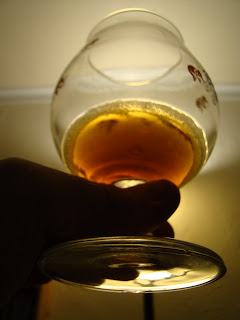 Other than working through my backlog of vintage bombers--I bottle one from each batch, and had them stretching back three years and understandably some have stood the test of time better than others–our homebrew consumption has been limited to IPAs and lacto-soured beers since we got to town. Ready for a change of pace, my first Salt Lake City brewday was devoted to the other end of the spectrum: dark, roasty, and malty.
Other than working through my backlog of vintage bombers--I bottle one from each batch, and had them stretching back three years and understandably some have stood the test of time better than others–our homebrew consumption has been limited to IPAs and lacto-soured beers since we got to town. Ready for a change of pace, my first Salt Lake City brewday was devoted to the other end of the spectrum: dark, roasty, and malty.The first beer in the mashtun was a fairly conventional dry stout. Last year’s stouts taught me to stick with darker British roast malts for these beers; the depths of darkness they impart do not disappoint. The water report here shows a lot of minerals coming out of the tap, so I cut that supply with a significant portion of RO water. Cereal mashing still gives me the willies, for some reason; it was probably unnecessary in this case, but I went through it anyway with my flaked barley. Moderate bittering came from Challenger and Northern Brewer, and Nottingham yeast came in to give a light English flavour and flocc out quickly.
I did another overnight mash for this one to move along the brewday, particularly as I also brewed a robust rye porter following the stout. It took a little while to get my bearings brewing in our new digs, but it’s really nice to have the turkey fryer set up right outside the kitchen door, all of maybe ten feet from the sink. The beer sat waiting to be bottled for an extra week and a half past when I wanted to get it bottled, but no harm was done. Just waiting for this batch (and its brother porter) to carb up and get us in the mood for our first Mountain Time Zone autumn.
SLC Dry Stout
Batch size: 5.25 gallons
Projected OG: 1.044
Projected SRM: 32.4
Projected IBU: 31.7
Boil time: 60 minutes
Brewhouse efficiency: 83%
Grains
62.5% - 5 lb 2 row
25% - 2 lb Flaked barley
6.25% - 8 oz UK RB
6.25% - 8 oz UK Chocolate
Hops
.5 oz Northern Brewer (10.5%) (60 min)
.5 oz Challenger (7.2%) (60 min)
Yeast
1 pkg Nottingham
Water additions (mash)
4 qts RO water
Brewday: 3 September 2011
Cereal mash: Flaked barley and 1 lb 2-row with 5 qts @ 125F for 15 minutes.
Heat slowly to 165F and add to main mash
Mash-in: 5 qts (plus 5 qts in cereal mash) @ 154F overnight
1st sparge: 10 qts @ 200F
2nd sparge: 10 qts @ 180F
Pre-boil volume: 6 gallons
Pre-boil SG: 8.8P (1.035)
Into swamp cooler in low 60s; activity within 15 hours.
Bottled: 25 September 2011
FG: 1.011
ABV: 4.3%
Bottled 5 gallons with 3 oz table sugar.





